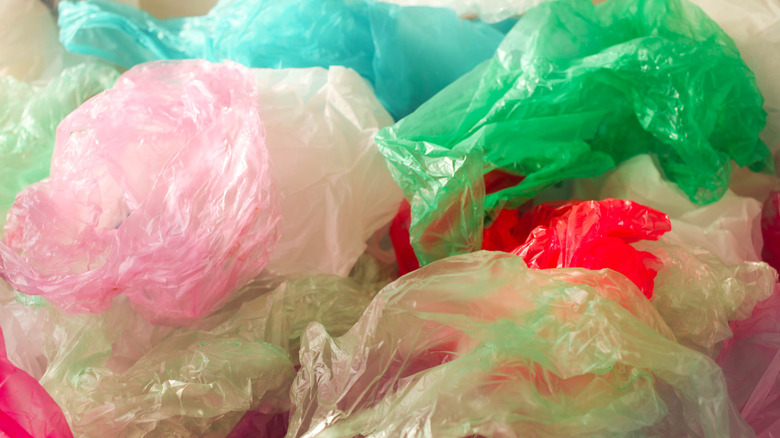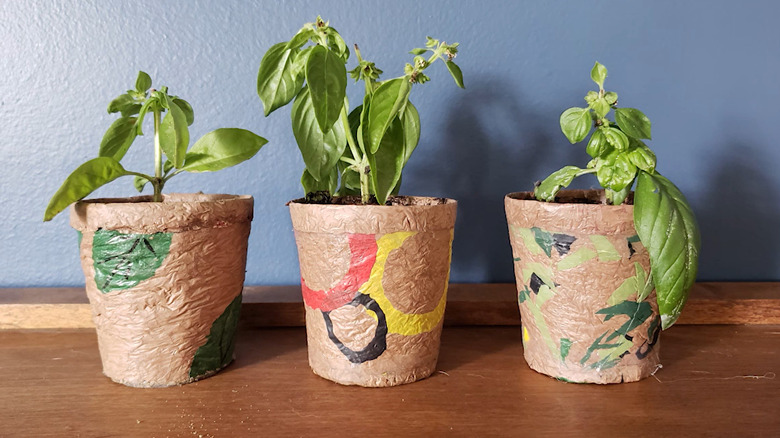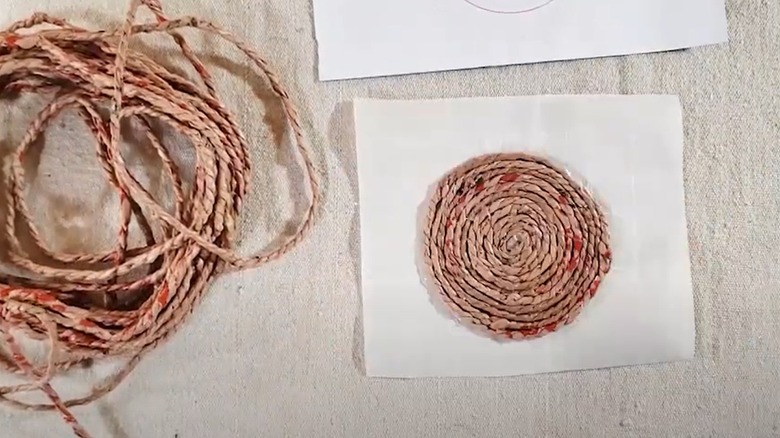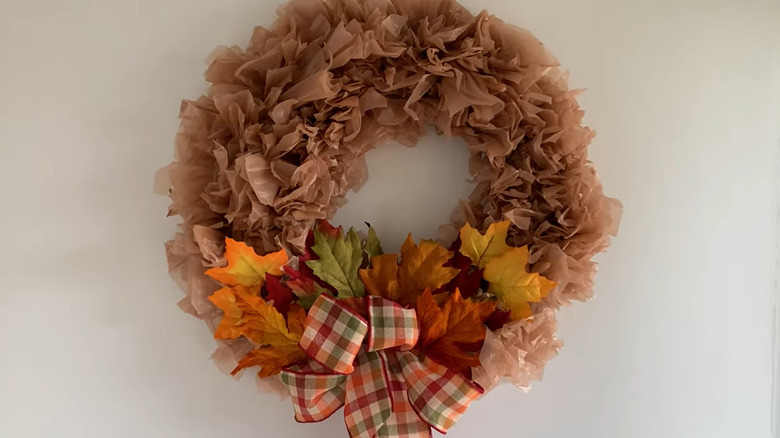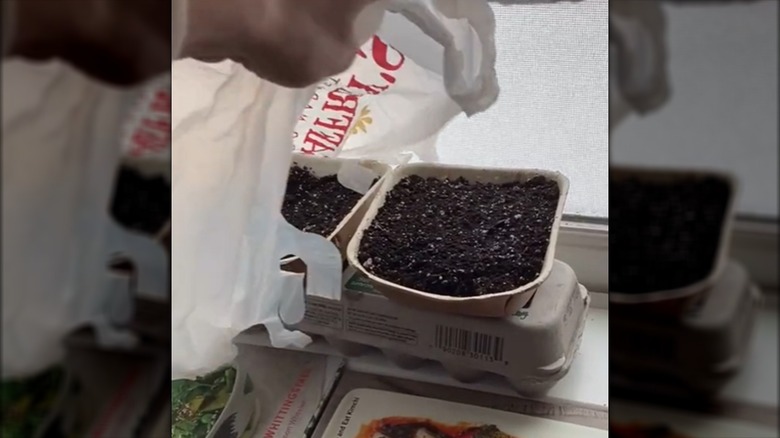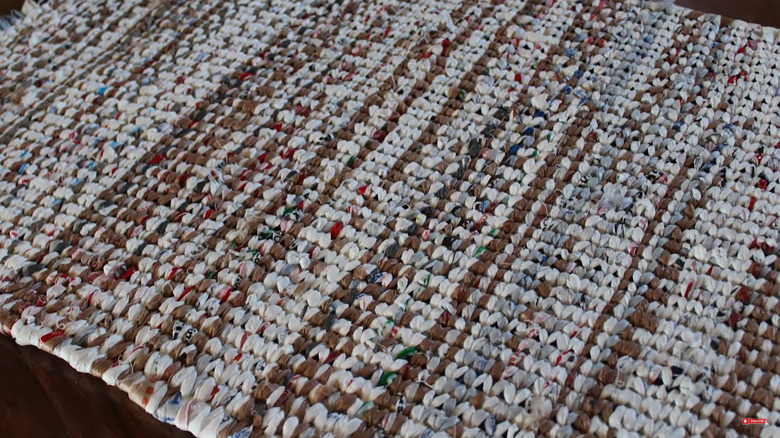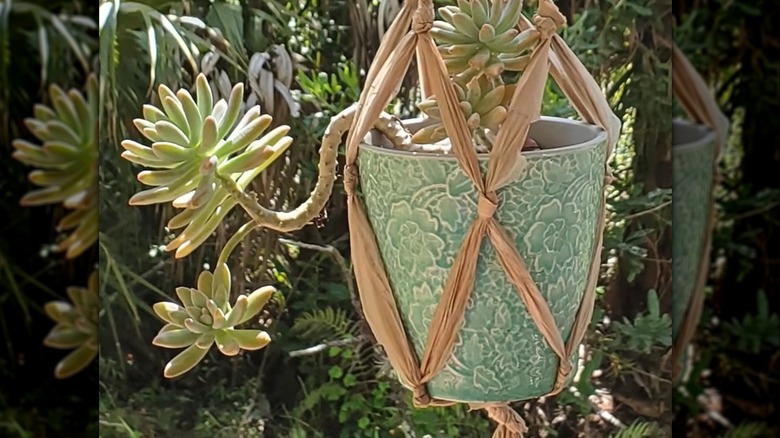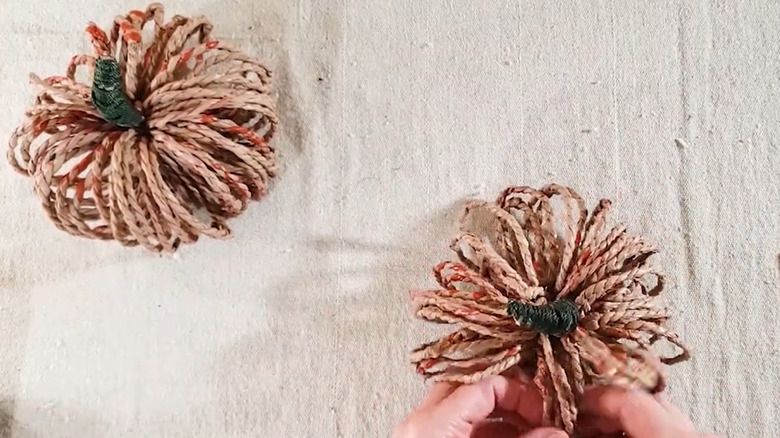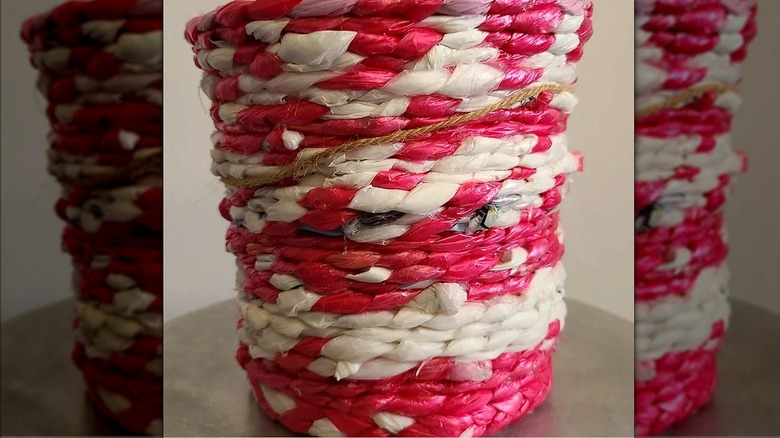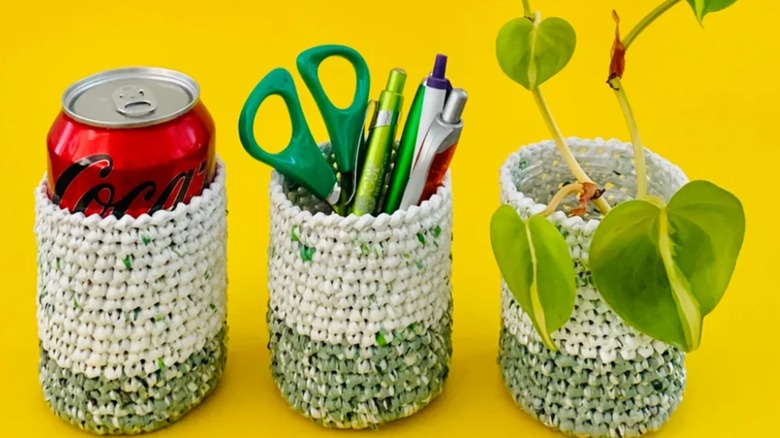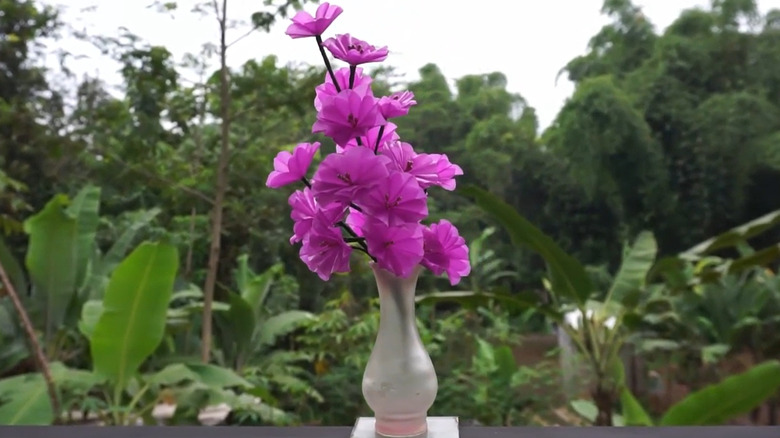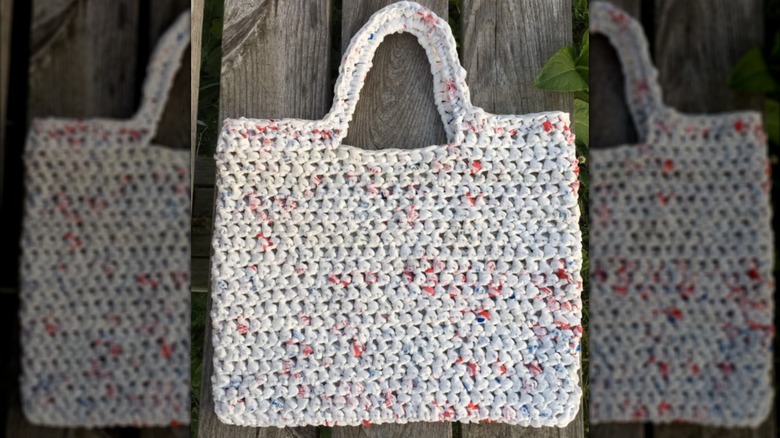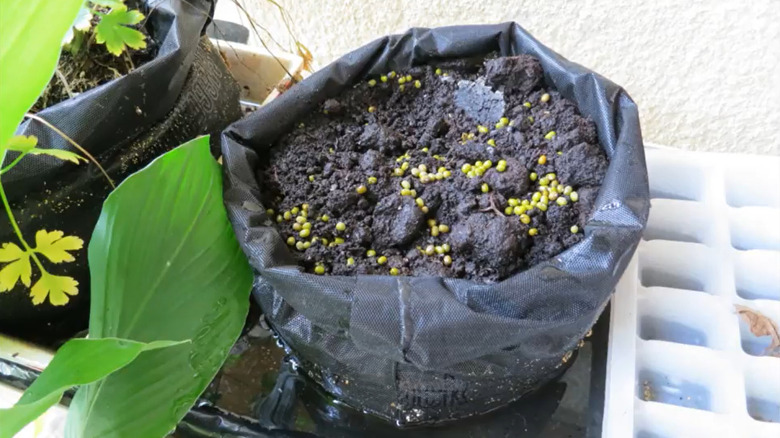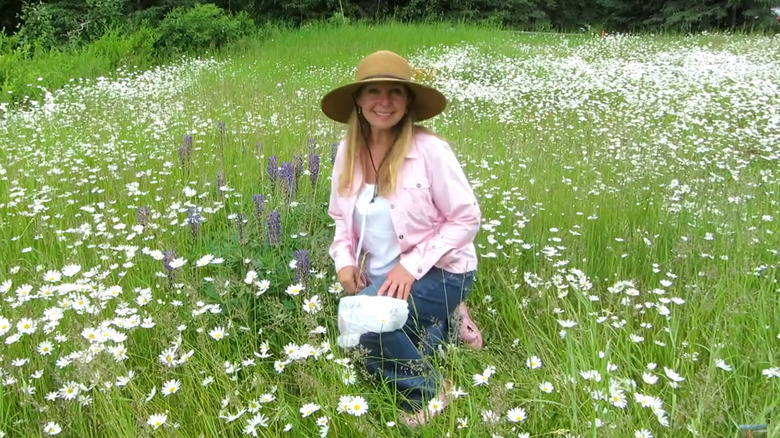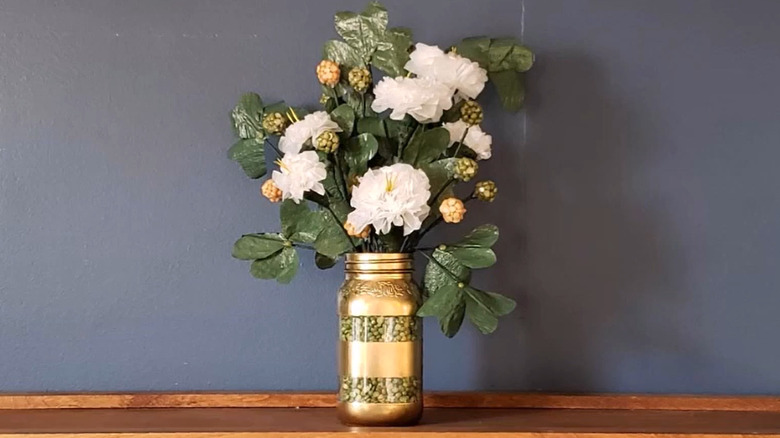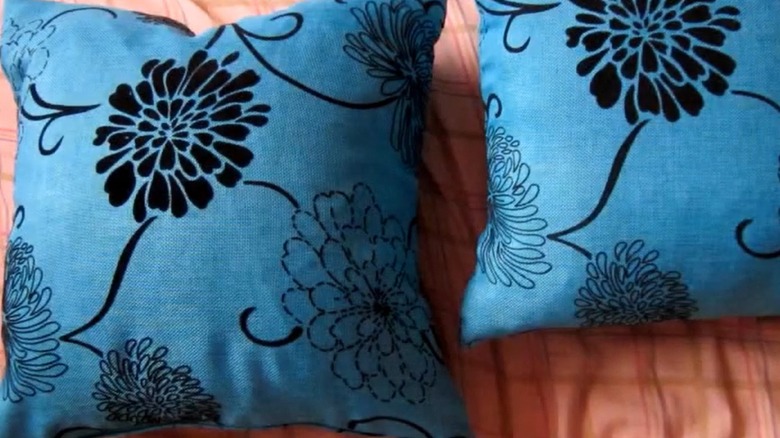15 Creative Ways To Repurpose Your Plastic Grocery Bags To Use Around The House
Has this ever happened to you? You get to the checkout at the grocery store, and you realize you left your collection of reusable bags in the car. Even the most teetotal zero-waster has probably been guilty of this memory lapse at least once. Well, since you're coming home with a hefty supply of plastic bags (Oh no, they're double-bagging!), discover some imaginative ways to reuse them. Sure, lining small trash cans and picking up pet waste are no-brainers, but what about transforming these environmental scourges into useful and even beautiful items that take advantage of plastic bags' ability to last pretty much forever? From gardening kneelers to woven rugs to bouquets of flowers that will never wilt, we've got you covered for clever ways to repurpose plastic grocery bags.
Bust out your stash of neatly stored plastic bags and get ready to start crafting. These ideas range from no-tools, no-skills DIYs to patiently-crafted fiber art. Use them as-is, iron them into fabric, or cut them into strips to make rope or plarn for weaving, crocheting, or knitting. No matter what their next life looks like, the world is better off with a bit of creative upcycling.
Planter cover
Melting a few layers of plastic bags together with an iron is a simple way to make sheets of water-resistant fabric to decorate planters. Cut open 10 grocery bags, trimming off the ends and handles. Lay them flat on a piece of parchment paper. Cover with another sheet of parchment paper, and iron the stack slowly on medium or medium-high until your layers are fused. Layer shapes cut from colorful plastic bags in with neutral-colored ones, and cut the sheet to fit around a potted plant. Hold the seam in place with a bit of hot glue.
Coiled coasters
Tan-colored grocery bags are pretty common, and they are a deceptively rustic-looking material. Either braided or made into twine or rope, coils of this faux-jute make lovely coasters. Using some parchment paper and a glue gun, adhere coiled plarn braids or twine onto the paper from the center out until you have a disc about 4 inches wide. Peel the coaster away from the paper, and reinforce the backing with more hot glue. Seal all of the openings between the coils for a water-resistant finish.
Festive wreath
Convert grocery bags into a wreath for any occasion. A single color of bags makes a nice unified look, but a mixture of tones could look equally impressive. Cut pieces of bags roughly 3 inches by 4 inches, avoiding handles and printed portions. About 15 bags will provide enough material to fill the inner and outermost rings of a 14-inch wire wreath form. Tie the pieces around the rings, packing them closely to each other. Top off your design with a bow, ball ornaments, or other seasonal baubles.
Mini greenhouse
Create a moisture-rich microclimate for growing things with little effort and less cost by using grocery bags as mini greenhouses. Tent a grocery bag over flats of seed starting trays, leaving space between the plastic and the tray to give seeds an extra bit of warmth and water retention. What's more, you can get plenty of use out of the same bag, either as a greenhouse or for another purpose.
Rug or mat
Whether they're braided, knitted, crocheted, or woven, grocery bag plarn can become a sturdy rug. If you have a loom, crafting a tightly-woven rug from skeins of plarn leaves you with a stylish entryway rug that will shock guests as to its origin. While weaving a rug will make a strong product because the plastic is woven with string, thick plarn braids coiled into an oval and sewn together is a savvy twist on a homey classic. A knit or crocheted kitchen mat will make a cushy spot to stand as you mix up recipes.
Plant hanger
A dangling plant suspended in a knotted, jute-look hanger complements a boho chic look perfectly. But, upon closer look, the fiber is plastic. Connect cut bag loops into four long strands. Knot the ends of all four strips together. About 12 inches down from the knot, begin making knots between all of the strands, two at a time, until you've linked all of the strands together into a sort of "net" that will hold a potted plant. For a more durable version, recreate this design with plarn that's braided or twisted into twine.
Fall pumpkin
Spin up some plarn twine or braid together some cordage to use for a fall pumpkin. Wrap the material around a can about 15 times, leaving loose ends about 4 inches long. Slide the loops off the can, and link them with wire in one spot so that the coils open like a book. Do this two more times. Reinforce the loose ends with wire to form a "stem". Connect the three coil sections with wire and glue in a way that all three stems come together. Combine the stem into one with a wrapping of green twine.
Basket
Whip up a basket from braids or rope made from plastic bags. Plying two colors together in a cord or braiding three colors will make a dazzling dotted effect. Coil the cordage like you would for a coaster, holding each rotation together with glue, wire, or heavy string. Make the base as large as you want your basket to be; you can even form it into an oval, square, or rectangle. Once the base is the size you'd like, continue attaching coils vertically. Either make the walls straight, or make each successive coil wider for a gradually widening basket.
Multi-use cup
A crocheted, knitted, braided, or twisted mini "basket" made from plarn can step in as a pencil holder, a planter, or a drink koozie. Use a soda can as a template for the plarn base and sides. The walls of the koozie should leave 1 to 2 inches of can above the koozie's lip so you can easily slip drinks in and out. This size works wonderfully for plenty of other applications as well. Use it to store toothbrushes, makeup, crafting supplies, or slide a jar inside it to serve as a vase for fresh flowers.
Faux flowers
There are scores of ways you can snip plastic bags into lovely blooms. Cut scalloped edged circles, bunch them together, or superimpose them for full floral heads akin to carnations or peonies. Granted, plastic grocery bags are pretty limited in their array of tints, so if you have brightly-colored carriers from other sources, they can join in as well. Cover wire loops with a piece of colorful plastic bag, or paint a neutral-colored piece for individual petals. Top lengths of floral wire or thin twigs with the blossoms, and enjoy a display all year round.
Tote bag
Some of the first transformations of bags into plarn we saw were used for knitted or crocheted bags. They hold up beautifully, and if you make the stitches loose enough, they make great beach bags to let sand through. Making your own can be as simple as whipping up a large rectangle to fold in half and narrow knitted, crocheted, or even braided handles, all sewn together with string.
Grow bags
Another extremely low-fuss way to reuse grocery bags is by using them to make a quick and easy no-dig vegetable garden. Poke drainage holes in the bottoms of two grocery bags, and slide one inside the other. Fill the bags with potting soil, leaving about a 4-inch margin between the soil and the opening. Fold over the bags' edges a few times for a reinforced lip. Water and wait for the bounty. Cover the tops of your grow bags with another plastic bag "greenhouse" to hold in a bit more moisture and warmth.
Knee protectors
Avid gardeners usually have a pair of pants with perpetually stained knees from kneeling in the dirt. Don't designate a piece of clothing only for outdoor work when you can make easy knee covers. Double-knot a bag around each knee with the knot in the back for free, upcycled stain prevention. Even the youngest plant fans get sore knees while tending to the soil. Make an effective kneeler from nothing more than a bag full of bags. Let it cushion your knees as-is, or place a bandana over top to keep your knees from getting too sweaty.
Shamrock leaves in bouquet
White and green grocery bags plus a few other potential pieces of trash come together as flowers and shamrock leaves in a mason jar bouquet. Green grocery bags can be hard to find, but you could sub the fused green plastic for pieces cut from coffee, pet food, or another bag. To create a shamrock, glue three green hearts to a stem. Bottle caps serve as the base for fluffy white flowers. Attach the flowers and foliage to the ends of floral wire, and slip the ensemble into a painted mason jar or another pretty vase.
Pillow stuffing
If you've ever noticed how squishy a bag filled with bags is, it's not hard to imagine it as pillow stuffing. Cram as many bags as you'd like into a pillow case and close it up for this clever patio pillow hack. However, as you sink into a bag-filled cushion, you'll hear an unsurprising plasticky crinkling sound. While that might bother you, it may not bother your pets. Fill a pet bed with bags, or even stitch one up from an old bed sheet or curtain, and your furry friend will have a cozy, sustainable nap spot.
